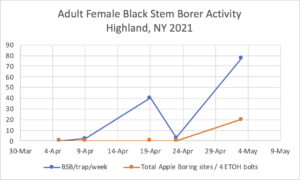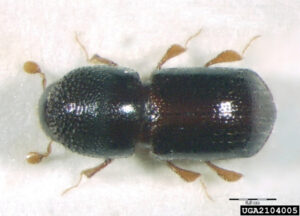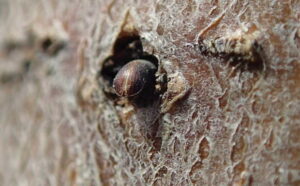Black Stem Borer: First Observation of Trunk Tunneling. May 4th, Highland & Walden NY.

Brief: As of the 9th of April of this year, black stem borer (BSB) adults have been found in Highland, NY. Traps baited with ETOH in various commercial orchards in the Hudson Valley have recently shown dramatic increases in populations. This may represent the onset of 2nd generation over the past week with double digit numbers of adult female flyers finding their way into our traps.
Upon the beginning of adult flight in April we placed ETOH soaked bolts of apple branches in our research orchard and grower sites to detect boring into apple under stress. Monday (May 3rd) we observed the first evidence of tunneling by BSB.
Growers should be scouting for BSB in newly planted apple blocks and trees up to 10 years, especially in heavy clay or thin shale based soil where tree losses have occurred. Boring sites may be dry or weeping dependent on site conditions. Holes are 1mm in diameter and very difficult to see. Upon evidence of boring activity, begin management at the first available application window..
Introduction: The black stem borer (BSB), Xylosandrus germanus is a forest pest in the U.S. introduced from Eastern Asia and first detected in New York in 1932. It has since been detected in most parts of the U.S. and recently detected in 2013 in six orchard sites in the Lake Ontario fruit region of New York.
These beetles have been responsible for the decline and demise of newly planted blocks and developing young apple trees in western New York.(Scaffolds July, 2014; Breth, Agnello & Tee).
Research in NY, Ohio and North Carolina have shown that trees growing in saturated soils (producing water stress) tend to develop and release ethyl alcohol as the root zone goes into anaerobic respiration during wet periods. The ethyl alcohol acts as a host finding mechanism to an insect complex known as Ambrosia Beetle of which the black stem borer is one of many species in this beetle group.
The black stem borer is a concern as it attacks apparently healthy plants that have undergone this form of ‘root zone anaerobic stress’.
Adults emerging in the spring locate stressed trees and begin burrowing entrance holes through the bark. The round entry holes are approximately 1 mm in diameter, often having long toothpick-like strings of frass or compacted boring dust emerging from these holes.
Beetles tend to borrow directly into the center of the wood and begin forming small chambers for egg laying and rearing of their young.

Dorsal view; black stem borer, Xylosandrus germanus
During a tour in Long Island by the CALS program work team (Tree Fruit PWT, July 2014), we came upon a Macoun on M-26 rootstock on a site that appeared to be on well drained soil, planted on a slope with good air drainage. There was no sign of herbicide injury such as cankered, flaking or scaling bark or winter injury. Yet the tree was completely yellowed with browning fruit.
The tree had completely shut down and was dying. The orchard had experienced two hurricanes over the past three years, with standing water. These conditions led to stress induced ethanol (ETOH) production that acted a signal for BSB to invade the tree. Over the course of a single season the tree appeared to suffer multiple invasions with development of galleries and introduction of fungal spores, which develop and wall off the transport capacity of nutrients to the canopy of the tree, causing its decline and death.
Biology: It takes about 30 days for development from egg to adult producing 2 generations per year with the ratio of females to males about 10:1. Late summer the beetles migrate to a hole lower in the trunk to overwinter with as many as 100 beetles in one chamber. The beetles go into diapause, becoming active again next spring.
Tree symptoms can include blistering of bark, oozing sap or fireblight ooze from entry hole, toothpick frass from entry hole ‘weather permitting’ as frass extension crumbles in rain and wind. The female cultures a fungal food source utilizing Ambrosiella hartigii and possibly Fusarium as food for the larvae and adults. She lays her eggs (tiny, ~1mm white, football shaped) in the chamber.
Larvae are also white with 3 instars prior to adult emergence.
Monitoring: Young tress showing leaf yellowing, poor extension and shoot growth, tip die-back, cankering or bark discoloring should be examined for BSB entry holes and toothpick frass.
To effectively monitor the insect, the use of bucket trapping for newly emerged adults should be used beginning at green tip employing ethanol solution as both a lure and killing solution, changed weekly. Beetles captured in the ETOH can be easily observed and as needed, identified by HVRL staff.

Black Stem Borer adult female blocks the tunnel and dies while her brood develop in a chamber lined with a fungus she carried in to feed them. (Photo by Liz Tee)
Females take flight from overwintering sites to infest trees when temperatures exceed 68°F, typically beginning in mid-late late April in the Hudson Valley with boring activity shortly there after.
In one study BSB flight occurred approximately 4 days after first bloom on Norway maple, and full bloom on border Forsythia. A second generation occurs in late July or early August, based on literature from Ohio. Yet trap captures have shown overlapping adult presence, and as such, generations have been difficult to separate by distinct flight peaks.

BSB entry site and burrowing found in Highland, NY in 2nd leaf Pink Lady on M9 – Nic29 rootstock (2015)
Management: The damage thus far has been observed primarily to young trees planted in tall and slender spindle plantings, in wet or non-irrigated soils. To control BSB in newly budded trees, the ornamental nursery industry employs pyrethroids on a two-week schedule to reduce injury from the insect. Warrior II or Winfield Solution’s Grizzly Z, lambda-cyhalothrin, are presently labeled for tree borer species. Efficacy data is presently unavailable as trials in tree fruit are on-gong. The points of entry can be as high as 4 feet above the ground into the tree scaffold limbs, which may preclude the use of post bloom Lorsban used in graft union burr knot control of dogwood and trunk borers.
Generally, neonicotinoids, anthranilic diamides (cyazypyr, acelepryn), and tolfenpyrad, have not been found to be effective in controlling BSB.


